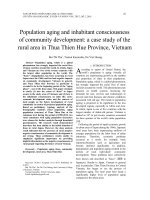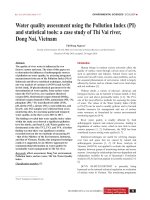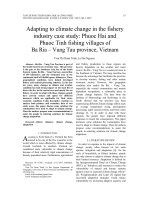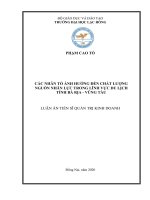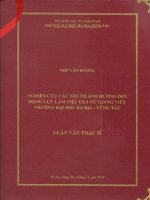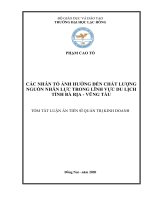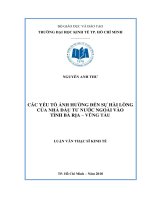Geologic resources vulnerability assessment to orient for vietnam coastal bays sustainable use a case study of ganh rai bay, ba ria–vung tau province, vietnam
Bạn đang xem bản rút gọn của tài liệu. Xem và tải ngay bản đầy đủ của tài liệu tại đây (711.08 KB, 10 trang )
GEOLOGIC RESOURCES VUL ERABILITY ASSESSME T TO ORIE T FOR
VIET AM COASTAL BAYS SUSTAI ABLE USE (A CASE STUDY OF GA H RAI BAY,
BA RIA – VU G TAU PROVI CE, VIET AM)
GUYE THI HO G HUE1, MAI TRO G HUA 2, GUYE TAI TUE3,
GUYE THI MI H GOC1, DO THUY LI H1, PHAM BAO GOC1, LUU VIET DU G1
1
Hanoi University of Science, VNU, Hanoi,2Vietnam National University (VNU), Hanoi,3 Ehime University, Japan
ABSTRACT: Ganh Rai is one of the important bays in the East of Nam Bo in particular and Vietnam in general. This
area has diversified resources, especially geological resources (geosite with high developing of seaport, geotopes with
beautiful beaches, wetland with abundant mangrove etc.). They are advantageous conditions to improve the economic
development such as marine transportation, aquaculture and fishing, tourism, etc. However, hazards such as erosion,
channel siltation, sea level rise, oil spill, environmental pollution etc., and activities of unsuitable resources exploitation
and utilization have degraded environment, decreased biodiversity and increased vulnerability. Therefore, it is necessary
to assess the geological vulnerability for sustainable use.
Based on the three components (vulnerability factors, vulnerable objects and resilience capacity) the vulnerability of
Ganh Rai bay has been assessed in 4 levels including: low vulnerability (off1shore areas in Tan Thanh and Ba Ria town),
medium vulnerability (Thi Vai riverine area, coastal area of Ba Ria town etc.), high vulnerability (coastal area in Vung
Tau city, area of 016m water depth etc.) and very high vulnerability (coastal and estuary areas in Vung Tau city). Based
on this assessment, some solutions on management, education and awareness, hazards mitigation, geological resources
use planning (eco1agriculture, silvo1fishery, eco1tourism, seaport developing and management together etc.) for
sustainable use of geological resources have been proposed.
Key words: geologic resources, vulnerability, Ganh Rai bay, hazard, sustainable use
I TRODUCTIO
Along approximately 3,260km of coastline, Vietnam has
48 coastal bays and shelters with total area of 3,997km.sq.
Those bays and shelters take an important role in socio1
economic development and national defense [19].
Located in the coastal zone of Dong Nam Bo region,
between Vung Tau and Ho Chi Minh City and Ganh Rai
bay is contiguous to Can Gio Biosphere Reserve (fig.1).
The bay is rich of natural resources, especially geologic
resources. There, geologic resources are product of
geologic process that human be able to exploit and use
[15]. There are 2 groups of geologic resources: non1
renewable (minerals, geotopes, and position resource) and
renewable (a part of wetland). Ganh Rai bay has geosite
which appropriate for developing sea1port industry (Vung
Tau port, Cai Mep port); has beautiful beaches what are
concerned as a geotope (Bai Truoc, Bai Sau, Bai Dua); is
rich of wetlands with abundant mangrove and biodiversity
ecosystem in Tan Thanh, Ba Ria; and is diversified
minerals. All those resources are creating potential for
socio1economic (tourism, sea1port, aquaculture, fishery
etc.) for this area and adjacent zone.
Although, Ganh Rai bay is impacted by vulnerability
elements, especially disasters (as erosion from Cua Lap to
Nghinh Phong coast; river and flow change due to
siltation in Lap estuary and Dinh estuary); environmental
pollution in sea1ports as Cua Lap, Sao Mai 1 Ben Đinh,
Cat Lo, Thi Vai; and oil spill etc. Additionally, there are
some threats from developing activities as unsustainable
development of aquaculture and fishery in Cua Lap, Dinh
estuary, Long Son etc.; sea1 transportation and tourism in
Vung Tau, industrial development in Phu My, My Xuan,
Tan Thanh. Beside, the resilience capacity of natural 1
social
system
(geologic
resources
protection,
management, community awareness about geologic
resources functions and values etc.) is not enough. Those
elements and threats give bad impact on geologic
resources as quantity reduction, quality degradation, loss
of biodiversity, and environment pollution lead to
increasing vulnerability of geologic resources. Therefore,
geologic resources vulnerability of the bay is assessed
base on selected criteria. The result of research will
contribute to orient for sustainable use of Vietnam coastal
bays by conducting appropriate management solutions,
raising community awareness, adopting of use plan, and
mitigating hazard effects.
413
Figure 1 Location of study area
STUDY METHODS
Nowadays, methods and criteria for vulnerability
assessment are set up base on 3 groups: vulnerability
factors (hazards and hazard enhancement factors);
vulnerable objects (urban zone, industrial zone, economic
zone and multi1resources etc.); and resilience capacity of
the natural1social system (infrastructure, people's
intellectual level, health, gender etc.). Especially,
application of past and ongoing demonstration models as
Social Vulnerability Index of Cutter and NOAA [2,3,8]; A
vulnerability index for the natural environment of SOPAC
[18]; Coastal Vulnerability Index of United State Geologic
Survey [5]; Guideline of vulnerability assessment for
Vietnam coastal natural 1 social system of Mai Trong
Nhuan and colleagues [6,9,14,17]. By consolidating and
assembling the past and ongoing methods and applying
them in the condition of Vietnam coastal bays, a model of
geologic resources vulnerability assessment of Vietnam
coastal bays is conducted (fig. 2)
Figure 2 Model of geologic resources vulnerability assessment of Vietnam coastal bays
414
GEOLOGIC
RESOURCES
ASSESSME T
VUL ERABILITY
Assessment Criteria
Geologic resources vulnerability assessment criteria are
divided into 3 groups: vulnerability factors (hazards and
hazard enhancement factors); vulnerable objects (geologic
resources); and resilience capacity of the natural1social
system. In selected criteria, some criteria are both
vulnerability factors (and vulnerable objects) and
resilience capacity (Table 1).
Criteria of vulnerability factors
Hazards: including erosion, river flow change by siltation,
storm and flood, sea level rise, oil spill, environmental
pollution and earthquake. Selected information includes
intensity, frequency and sphere of influence of each
hazard. In there, erosion, river flow change by siltation,
storm and flood, sea level rise, oil spill, environmental
pollution occur at strong intensity, great frequency on a
large area. Then, storm and flood, sea level rise and
earthquake.
Erosion occurs strongly along the coastline from Cua Lap
to Nghinh Phong headland (creating a cliff with 111.5m in
height). In comparison with the UTM map in 1965, the
coastline encroached upon continent hundreds meter,
especially in recent years, the encroachment is 121
15m/year [7]. The consequences of erosion are destroying
sea walls, decreasing the landscape values of sea beaches,
threatening local people and their house and causing loss
and degradation of mangrove and protective forest.
Flow change due to siltation occurs at almost estuaries and
sea1ports in the study area. As in Lap estuary, siltation
created a system of sandbar with length of 0.511km and
other submerged sandbars in the estuary [12, 13]. The
sandbar creation process speeds up erosion and flow
change in the area, causes difficulty for river and maritime
transportation. In order to maintain and develop the
maritime transportation and protect geosite (sea1port)
here, local government has to spend a great expense to
dredge the river bed and seabed. According to Ministry of
Natural Resources and Environment, toward 2020,
estimated mass of sediment has to be dredged in 18 flows,
seaport, river and industrial zone is 27.6mil.m3 and the
estimated cost reaches to 128 billion VND.
Sea level was forecasted rising from 23 to 117 cm in the
year of 2050 and 56 to 345 cm in the year of 2100 [20].
According to Nguyen Ngoc Thuy, the average rate of sea
level rise in the coastal zone of Vietnam is 2mm/year.
And, UNDP has noted that Vietnam is a country affected
most seriously by sea level rise. In the case of sea level
rise of 1m, approximately 1/5 population will lose their
houses, 12.3% cultivated area and 40,000 sq.km of coastal
land (mostly coastal wetlands) are under damage. Total
damage cost is estimated about 17 billion UDS/year [2].
So, in Ganh Rai bay, sea level rise will effect seriously on
most area of Vung Tau city to Ganh Rai headland
(especially wards of 11; 12 and Long Son commune,
Vung Tau city) and coastal communes from Tan Thanh
district to Ba Ria town; threaten directly to coastal
wetland types, damage to tourism, transportation and
aquaculture etc.
Oil spill problem occurs sometimes and causes serious
consequence to resources and environment of coastal zone
in general and coastal bays in particular. According to
Vietnam Environmental Protection Agency, up to June
2007, total damage due to oil spill problem in Viet Nam is
estimated approximately 76.8 billion VND, including 1.2
billion VND for oil collecting; 44.9 billion VND for
tourism; 28.4 billion VND for aquaculture and fishery;
and 1.6 billion VND for agriculture. In Ganh Rai bay, oil
spill problem occurs with a great frequency, mainly due to
sea1 transport accidents and leaking oil from vessels.
During period of 199311998, there was 30 shipwrecks
discharged 3,200 tons of oil into the bay [12]. E.g. the
accident of Formosa One vessel and Petrolimex vessel on
September 7th 2001 spilled 750 tons oil to the sea,
affected seriously to economy and environment of coastal
zone from Nghinh Phong headland to Sao Mai – Ben Dinh
resort (photo 2). Recently, there is an oil leakage during
February to March 2007 which caused a serious
degradation to coastal ecosystems. Collecting oil volume
in sea beaches in Vung Tau reaches to 12 tons.
Environment of Ganh Rai bay is potentially polluted by
Mn, Pb and Cd in sea water and Hg, Sb, As in sea
sediment [10, 12, 13]. Specifically, water environment is
likely polluted by Pb in the west area of Cu Lao Ben Dinh
with concentration of 12 1 14.1014mg/l (higher than 40
times in comparison with average concentration of Pb in
the world sea water, but less than standard level in
Vietnam Environment Quality Standards 594311995).
The concentration anomaly of Mn, Cd at Mui Giui
estuary, Dinh estuary (015m water depth) ranges from 120
to 210x1014mg/l and 3.5 to 6,4x1014 mg/l (higher than
average concentration of Mn, Cd in the world sea water
from 6 to10.5 and 3.5,5 to 6.4 times). In shallow sediment
(to 0 to 6m in depth), the The concentration anomaly of
Hg is determined at Ben Dinh, Long Son communes and
Nga Bay, Cai Mep estuaries, with concentration of 0.3 to
0,5x1014%. The concentration anomaly of Sb distributed in
some area surrounding Cai Lo port and Cai Mep estuary
with concentration of 4 to 5x1014% (2.8513.57 times
higher than Threshold effect level of the Canadian
Environmental Quality Standards).
415
Photo 1 Collapse sea1wall in Thuy Duong resort due to erosion
Hazard enhancement factors: Human activities enhance
hazards as erosion, siltation, salinization and pollution,
include: industrial activities (an enormous waste from
Vedan factory flows directly into Thi Vai river is 105,600
m3/month and the waste from My Xuan A and Nhon
Trach 1 industrial zones etc.); maritime transportation
(municipal waste and oil from ports as Cai Mep, Sao Mai
1 Ben Dinh, Dinh River); oil spill problems; excessive
aquaculture; destroyed fishery (explosives, electrical
impulse) and mangrove cut1down to enlarge aquaculture
ponds and salt fields (in Long Son commune, ward 11,
Lap estuary etc.). Add to that are some detrimental
features of natural condition of coastal zone, for example
topography, geomorphology, coastline sedimentary
formation (mud, sandy mud, sand and rock) which can
enhance or reduce the effect of hazards.
Criteria of vulnerable objects
Geosites: including headlands as Nghinh Phong, Ganh
Rai; sea1ports as Vung Tau – Dinh River, Cai Mep River;
estuaries as Dinh, Mui Giui, Cai Mep, Lap. Those geosites
are exploited rapidly for tourism as in Nghinh Phong, Nui
Lon, Nui Nho tourist areas, sea1transportation and
aquaculture. Beside, headlands in the region created
closed bays with weakly affected by waves and winds
dynamic appropriated for stormproof of sea1transports.
Photo 2 Oil spill in September 2001
sightseeing, swimming and holiday supplements. The
tourist areas, developed in this type, include Truoc beach,
Sau beach, Dua beach, Thuy Van beach, Paradise resort
(photo 3).
Wetlands: including 9 types of wetlands in this area, e.g:
shallow sea at less than 6m water depth; estuaries; sandy
intertidal flats; muddy flats; mangrove; aquaculture ponds;
salt fields; rivers, streams; and rice fields [16]. Wetland
type of shallow sea at less than 6m water depth covers
about 5,138 ha and is a famous national fishing ground.
Estuaries have total area about 1,213 ha and are favorable
for developing aquaculture, transportation and sand
exploitation, especially at Lap and Dinh river estuaries.
Mangrove in this area covers 10,819 ha, get an important
role as environmental suffer zone and storm prevention.
But, most of mangrove is converted into aquaculture
ponds (in Long Son commune, ward No.11 and ward
No.12 of Vung Tau city) and industrial zone, urban along
the 51 road (photo 4). Aquaculture ponds cover about
1,524 ha, mainly on estuarine mangrove area.
Minerals: including ilmenite placer in Vung Tau with total
reserves of 70,000 tons [12, 13] and constructive materials
as: stone (165x106m3); paving stone (7,14x106m3); glass1
sand (41,106 ton); clay (3x106m3); additive for cement
production (52.5x106 ton) [21]
Geotopes: sea beaches, which are characterized by gentle
slope and white sand, create a favorable place for
Photo 3 Sau beach (Vung Tau city)
Photo 4 Mangrove forest along the 51 road
416
Criteria of resilience capacity
Recilience of natural systems: including mangrove
ecosystems, estuaries, headlands, sandy/muddy flats,
shallow sea at less than the lowest tide 6m water depth.
For example, mangrove has great values and significant
function on economy and environment (climate equable;
sediment trap and land1based pollutants buffer zone, storm
and erosion prevention). So, mangrove is concerned as
highest resilience system to effects of hazards (or reducing
the vulnerability). Then, coastline solid rocks at Nghinh
Phong headland, which are granite of Deo Ca formation
and igneous rock of Nha Trang formation, have a good
resilience and loading capacity, oily unabsorbability, and
mitigate the impact of erosion, oil spill, sea level rise,
storm, flood and pollution. Whilst, unsolid coastlines at
estuaries and tidal flats highly absorbed oil and
accumulated pollutants, destroyed easily by waves,
currents, and are sensitive to impact of erosion, oil spill
problems and pollution. So, those coastlines have a bad
resilience.
Resilience of social systems: including criteria for
assessment of education, management, organization,
protection and hazard response (number of schools,
number of teachers, legal matter, and garbage collection)
and infrastructure (transportation, number of transmitting
stations). In there, education and training in study area
develops rapidly with good facility schools and numerous
numbers of teachers (accounting for 9,800 teachers; about
122.5 teachers/ten thousand persons). The quality of
education is very good: the annual percentage of students
graduating from primary school reach 99%, secondary
school 90%, and high school 95%. This is an important
base to evaluate local people’s awareness and local
community participation in natural resources protection
generally and geologic resources particularly. On the
contrary, the rate of unemployed people at the working
age and the rate of population growth are high (accounting
for 2.43%, and 13.66%) [1] and the distribution of
residents is uneven (387,267 urban people, 497,578 rural
people) to cause reducing the resilience of local
communities.
Table 1. Geologic resources vulnerability assessment criteria for Ganh Rai bay, Vung Tau province
Factors
Criteria of
vulnerability
factors
Criteria of
vulnerable objects
Criteria
otes
Hazards
1
Erosion
1
Siltation
1
Sea level rise
1
Storms and floods
1
Oil spill problems
1
Pollution
1
Earthquake
Hazard enhancement factors
1
Natural condition: topography, geomorphology,
coastline sedimentary formation (mud, sandy mud,
sand and rock
Human activities: mangrove cutdown, industry,
agriculture, tourism, martime transportation, aquacultre,
fishery, mining, salt production
Geosites
1
Headlands
1
Sea1ports
Geotopes
1
Beaches
Coastal landscape
Wetlands
1
Shallow sea at less than lowest tide 6 m water depth
1
Estuaries
1
Mangroves
1
Sandy/muddy flats
1
Aquaculture ponds
1
Salt fields
1
Rivers and streams
Rice fields
Minerals
1
Ilmenit placer
Constructive meterials
417
Geologic fomations enhance or
reduce the effects of hazards (good
resilience):
1 Sandy and muddy fomations are
weakly resistant to effects of
harzard (sensitive to impact of
erosion, oil spill problems, sea
level rise and pollution).
1 Rocky coastlines reduce above
effects
Some vulnerable objects are
resilient from effects of harzards,
including
headlands,
rocky
coastline,
muddy/sandy
flats,
mangroves, and estuary (see
above).
Factors
Criteria of
resilience
capacity
Criteria
otes
Resilience of natural systems
1
Mangrove ecosystems
1
Esturies and shallow sea at less than lowest tide 6 m
water depth
1
Rocky headlands
1
Muddy/sandy flats
Resilience of social systems
1
Education
1
Natural resources management, environmental
protection and hazards mitigation
Infrastructure (transportation, number of transmitting
stations)
Ganh Rai bay geologic resources vulnerability zoning
Geologic resources vulnerability assessment is based on 3
groups of factors and criteria (tab. 1). Result of the
assessment is the overlap of vulnerability index by the
danger level from vulnerability factors, vulnerable objects
density and resilience capacity of the natural 1 social
system per unit area of the topographic map at scale of
1/100,000. By algebraic map method, vulnerability index
is determined on each map square unit. Basing on the
index, Ganh Rai bay is divided into 4 zones following the
vulnerable levels (fig. 3).
Zone I: 1 low vulnerability zone covers 18.72% total study
area, distributes on mountain land in the west of Ba Ria
town (Hoa Long and Long Phuoc communes) and north of
Tan Thanh district (Chau Pha, Toc Tien, Hac Dic
communes). This is inland zone with low vulnerable level
(only influenceable by earthquakes, weak storms and less
impacted by human activities). The density of geologic
resources (vulnerable objects) in this zone is low (only
constructive materials and small area of rice fields). The
resilience capacity of this zone is at medium level.
Zone II: 1 medium vulnerability zone covers 15.30% of
total area, distributes mainly in Tan Thanh district (Phuoc
Hoa and Hoi Bai communes), Ba Ria town (Long Huong,
Phuoc Trung, Long Toan, Phuoc Hung communes) and a
small offshore area of Long Son commune, wards 4, 7 and
9 (Vung Tau city). This zone has medium to high level of
vulnerability (effect by sea level rise, storm, floods,
pollution and impact of hazard enhancement factors as
transportation, industrial zone in Than Thanh and Thi Vai
River basin, mangrove cut1down to develop aquaculture
and salt production in Long Son, Long Huong). The
density of vulnerable objects in this zone is quite high, e.g.
the most abundant mangrove in the area, many ports in
Thi Vai river, many aquaculture ponds, salt fields and a
dense river/flow system. But, the resilience capacity of
this zone is quite high, because of large area of mangrove
in Vung Tau city that has a good resilience.
Zone III: – high vulnerability zone covers a large area
(43.53% of total area), includes: wards 2, 5, 6, 11 and
hamlet number 9 of Long Son commune of Vung Tau
city; Ding estuary, Phu My town (Tan Thanh district) and
shallow sea at less than the lowest tide 6 meters water
depth. The zone has high level of vulnerability due to:
strong effect of oil spill problems, pollution, sea level rise
and siltation; dense of vulnerable objects as geosites
(headlands, sea ports), geotopes (beaches), wetlands
(mangrove, salt fields, aquaculture ponds, sandy/muddy
flats and shallow sea at less than the lowest tide 6 meters
water depth; high resilience capacity (good resilience of
mangrove and other vulnerable objects by sea dike and
wall system, high people's intellectual level, good
coastline protection management).
Zone IV: 1 very high vulnerability zone covers 24.45% of
total area, includes coastal zones of Long Son commune,
wards 1 and 10 of Vung Tau city, estuaries as Cai Mep,
Ong Ben, Mui Gui, Lap. This zone has a high vulnerable
level due to strong effect of oil spill problems, siltation
and high consequence of human activities which enhanced
hazards effect as dense of population, fishery and
aquaculture, sea transportation… In this zone, the density
of vulnerable objects is very high, e.g. mangrove
ecosystem (in Phuoc Hoa commune, flats between Ong
Ben and Mui Gui estuaries, coastline from Long Son to
Mui Giui); geosites (sea1ports in Vung Tau and Lap
estuaries); geotopes: (sea beaches in wards 1 and 10 of
Vung Tau city); wetlands (aquaculture ponds, estuaries,
salt fields). And, the resilience capacity of this zone is
quite high basing mainly on resilience of coastline and
mangrove here.
The result of research show that very high vulnerability
zone usually has the overlap among the zone is affected
strongly by hazards (erosion, siltation, sea level rise) and
environment problems (oil spill, pollution) with the zone
has high dense of vulnerable (geosites, geotope, wetlands,
mangrove) and the zone has medium to high resilience
capacity (basing on resilience of mangrove, infrastructure
and good organization for resources management and
hazard mitigation). Low vulnerability zone usually is
weakly affected by vulnerability factors and low dense of
vulnerable objects (few sensitive ecosystems) and medium
resilience capacity.
In the coming years, geologic
resources vulnerability is predicted increasing due to
climate global change (especially directly influenced by
sea level rise) and threats from unsustainable exploitation
and use of geologic resources (e.g. mass of waste
discharge from Thi Vai River into Ganh Rai bay.
418
Figure 3 Diagram described the vulnerability of Ganh Rai bay
PROPOSED SOLUTIO S FOR SUSTAI ABLE USE
OF GEOLOGIC RESOURCES I GA H RAI BAY
The aim of geologic resources sustainable use in Ganh
Rai bay is to meet the needs of resources exploitation and
use in order to develop the regional economy and improve
the quality of life toward a justice and equality society and
environment protection, hazards mitigation, geologic
resources conservation.
In order to meet this aim, simultaneously enhance the
resilience capacity of geologic resources and decrease the
bad impact of hazards, the vulnerability geologic
resources in Ganh Rai bay needs to reduce. That is also
toward to suitable development 1 a development of
sustainable economy, society and environment [4].
Therefore, a series of solutions is proposed, including
management, education and propaganda, geologic
resources use planning and hazards mitigation. The
rationale of solution is based on the result of the
vulnerability assessment.
Management
Law and policy enforcement: geologic resources
exploitation and use have to abide not only by the national
systems of laws and policies, especially Environment
Protection Law, Fishery Resources Protection Law,
Minerals Law… but also by international laws and
conventions which Vietnam joined as Ramsar Convention,
Biodiversity Agenda… Otherwise, it is necessary to
enforce new policies to conduct and promote ecological1
economic models (eco1tourism, silvo1fishery, sustainable
mineral exploitation etc.); and establish a hazards
insurance fund to mitigate and share damages of hazards.
Especially, new sanctions and form of fines should be set
up and enforced to agents, factories which exploited
unsustainably causing loss of geologic resources,
degradation of landscape and environment. Beside that,
the environment restore law needs to apply and enforce to
the pollution sources (industrial zone, factories,
transportation means etc.). Additionally, it is necessary to
strengthen and consolidate the traditional customs, rules
and local regulations appropriating to environment
protection, hazards mitigation and sustainable use of
geologic resources.
Integrated Management was based on the result of
geologic resources vulnerability assessment and
conducted following characteristics of 3 groups of factors:
vulnerability factors (focusing on hazards management);
features of geologic resources (specialty management:
fishery, tourism, transportation etc.); and resilience
capacity (community based management). For the high
vulnerability zone, the management should focus on
hazards prevention and mitigation and resources
protection, and encourage conversion of resources
exploitation and use into ecological models. Beside, it is
necessary to focus on the propaganda and education to
raise community awareness about disaster prevention and
419
natural resources, environment protection; improve
management capacity and awareness about geologic
resources values and functions. Along with that is to
promote cooperation among managers, local communities
and other stakeholders in implementation of ecological
economic models and strengthening institutions, policies
for integrated management.
Education and propaganda
Education and propaganda aim to raise awareness about
geologic resources values and functions, sustainable
exploitation technology (fishery and mining) and threats
of geologic resources (especially erosion, oil spill
problems, storms and pollution). Education and
propaganda is a necessary solution to increase social
resilience capacity to the vulnerability cause factors. In
order to make effectively for the solution, it needs to focus
on education and propaganda objects as managers, local
people and students. In this, some principles to note are:
respect for the right and benefits that the community could
be brought from geologic resources; appreciate the
resilience, attract the active participation of communities,
stakeholders; education, propaganda should be carried out
continuously. Beside, it is necessary to have guidelines
and regulations for visitors to travel with the sense of
environmental and geologic resources protection via
newspapers, radio, television, the internet, leaflets...
Hazards mitigation
In the study area, there are only erosion prevented sea
walls in ward 1, ward 5 of Vung Tau city and at some
resorts of Thuy Van and Sau beaches. And, Ganh Rai bay
is affected seriously by oil spill problems and waste water
from urban and industrial zones. In order to mitigate the
damage from hazards, it is necessary to apply not only
solutions of management and education, but also technical
solutions as followings:
1 Strengthening and building anti1erosion sea wall along
the coastline of wards 1, 5, 8 and 11 (Vung Tau city);
1 Setting up monitoring stations system, warning and
forecasting for oil spill problems and environmental
pollution;
1 Restoring mangrove ecosystems in Long Son
commune, ward 11 (Vung Tau City), Huong Long
Ward (Ba Ria town) to create a suffer zone for
preventing waves, protecting environment, maintaining
biodiversity.
Geologic Resources use plan
Basing on the result of geologic resources vulnerability
assessment, different zones have different distribution and
exploitation form of geologic resources, therefore,
proposed activities need to meet spatial content and
requirements of the plan and implementation of priority
activities in order to increase the resilience capacity in the
zone. In there, prioritizing the application of geologic
resources sustainable use model (eco1tourism/sustainable
tourism, silvo1fishery, ecological agriculture and forestry
etc.) to reduce the bad impact to resources and
environment and conflict in geologic resources
exploitation and use. Beside that, application hazards
mitigation methods to reduce the loss of resources is
needed (table 2). Thus, in order to implement effectively
the plan in each region, it is necessary to have a good
cooperation and active participation of relevant
stakeholders in setting up and implementing plan and the
plan has to set up based on national enforcement laws and
regulations.
For example, in the high vulnerability zone, in order to
enhance the resilience capacity, planning should reduce
the negative impact from geologic resources exploitation
and use (transportation, sea ports, tourism, fishery and
aquaculture) and from hazards (erosion, oil spill problems,
and siltation). Therefore, proposed activities in planning
are: ecotourism (ward 1, 10 1 Vung Tau city), silvo1fishery
(Long Son 1 Vung Tau city), sustainable fishery and
mangrove protection, conservation (at estuaries) in
combination with hazard mitigation solutions.
420
Table 2 Solutions for sustainable use of geologic resources in Ganh Rai bay
Vulnerability characteristics
estuaries, coastal zones of ward 1,
10 and Long Son commune
(Vung Tau city)
Vung
Tau city (wards 2, 5, 6, 11, 12);
Dinh estuary and shallow sea
less than 6m water depth
Thi
Vai river banks, coastal wards of
Ba Ria town and wards 4, 7, 9 of
Vung Tau city
highlands, offshore parts and sea1
ports in Tan Thanh district and
Ba Ria town
Proposed solutions for sustainable use
1 Prioritizing investment and consolidation of anti1erosion seawalls and
siltation, protecting mangrove
1 Enhancing the response for oil spill problems
1 Applying ecotourism and silvo1fishery models, sustainable fishery and
integrated managing sea1ports
1 Prioritizing to invest in prevention and mitigation damages from erosion
and oil spill problems.
1 Applying and promoting new models of ecological economy as eco1
tourism and silvo1fishery, fishery and minerals sustainable exploitation
1 Prioritizing to apply and promote new models of silvo1fishery and eco1
agriculture, develop the sea1ports and manage effectively rivers and flows.
1 Protecting and conserving mangrove
1 Implementing the solutions to reduce the damages from hazards, pollution
and oil spill problems
1 Prioritizing to apply and promote new models of eco1agriculture and
sustainable mining
1 Launching programs of education and propaganda to raise local community
awareness about values and function of geologic resources
CO CLUSIO
ACK OWLEDGEME TS
Geologic resources vulnerability assessment criteria was
set up basing on 3 factor groups: vulnerability factors
(criteria of hazards and hazard enhancement factors);
vulnerable objects (multiform of geologic resources) and
resilience capacity.
This paper is completed with the support from the
fundamental research project coded 105.09.82.09
The result of geologic resources vulnerability assessment,
Ganh Rai bay is divided into 4 zones following the
vulnerability levels: low, medium, high and very high.
The very high vulnerability zone usually has high to very
high damage from hazards (erosion, siltation and sea level
rise), oil spill problems and pollution. This zone has high
density of vulnerable objects (geosistes, geotopes, and
mangrove) and medium to high resilience capacity (high
restoration and resilience of mangrove; good
infrastructure; good hazards response and geologic
resources protection). On the contrary, the low
vulnerability zone usually is weakly affected by
vulnerability factors and has low density of vulnerable
objects (few sensitive ecosystems) and medium resilience
capacity.
Based on this assessment, some solutions for sustainable
use of geological resources have been proposed such as
management (law and policy enforcement, community
based
management
etc.,),
hazards
mitigation
(strengthening and building anti1erosion sea and
monitoring stations system, warning and forecasting for
oil spill problems etc,.), geological resources use planning
(eco1agriculture, eco1aquaculture, eco1tourism, sustainable
fishing and mining, seaport developing and management
together etc.) and education and awareness.
REFERE CES
People's Committee of Ba Ria 1 Vung Tau, 2003.
Statistical office in Ba Ria 1 Vung Tau city.
Cutter SL (1996). Vulnerability to Environmental
Hazards. Progress in Human Geography 20, 529 –
539.
Cutter, SL., Mitchell JT., Scott MS (2000) Revealing the
Vunerability of People and Places: A case study of
Georgetown County, South Carolina. Annals of the
Association of American Geographers, 90(4), pp.713 –
737.
Duc LM (2003). Orientation and solution of Vietnam
Agenda 21. “Sustainable development of Vietnam”,
pp. 25137. In Vietnamese.
Elizabeth AP, Thieler ER, Williams SJ (2005). Coastal
Vulnerability Assessment of Point Reyes National
Seashore to Sea1Level Rise. Open'File Report 20051
1059. U.S. Geological Survey, Coastal and Marine
Geology Program.
Hien LTT, Nhuan MT, Y TV (2006). Vulnerability
assessment for environmental planning and
management (on example of Hai Phong city). Journal
of Earth Sciences, No 1 (T.28), pp. 1110. In
Vietnamese.
Marine Geology Division (2005). Investigate socio1
economic data of Ba Ria 1 Vung Tau in 2005.
Nhuan MT, Luyen DV, Hang NTT, Thanh PH, Hai TT
(2002). Evaluation of the vulnerability of the coastal
421
socio1natural systems (example from Khanh Hoa
coastal zone). Journal of Science, Vietnam ,ational
University. No 3, p. 25 1 33. In Vietnamese.
the coastal zone of Vietnam (on example of Vung Tau
1 Phan Thiet region). In Vietnamese.
Nhuan MT, Ha NTT, Quy TD, Ngoc NT, Linh DTT,
Ngoc NTM, Hue NTH, Ngoc PB, 2008. The
Vietnamese Wetlands Classification System. Journal
of Science, Earth Sciences 24 (2008) 961103.
Nhuan MT et al. (2004). Reseach and assessment of Nam
Trung Bo coastal zone vulnerability for hazards
mitigation and land use planning. In Vietnamese.
Nhuan MT et al. (2005). Integrated assessment of risk
level by hazards in Viet Nam coastal zone (case study
of Cam Ranh 1 Phan Ri coastal area). Journal of
Geology. Series A, No 291. In Vietnamese.
Nhuan MT, Ngoc NTM, Huong NQ, Hue NTH, Tue NT,
Ngoc PB. Assessment of Vietnam coastal wetland
vulnerability for sustainable use (case study in
Xuanthuy Ramsar site, Namdinh province). Journal of
Wetlands Ecology, (2009) vol.2, pp116.
Nhuan MT et al., 2005. Mapping of geo1environment
status and forecast of Ho Tram – Vung Tau (0 1 30 m
water depth) at scale of 1/100.000. In Vietnamese.
NOAA (1999). Community Vulnerability Assessment
Tool CD – ROOM. NOAA Coastal Services Center .
Nhuan MT et al. (2005). Research, establish
environmental geology map at Ho Tram – Vung Tau
(0 1 30 m water depth). In Vietnamese.
Pratt CR, Kaly UL, and Mitchell J (2004). Manual: How
to Use the Environmental Vulnerability Index (EVI).
SOPAC Technical Report 383.
Nhuan MT, Hue NTH, Quy TD, Tue NT (2005).
Vulnerability assessment of coastal zone from Phan
Thiet – Ho Tram, Vietnam for sustainable
development. Scientific Journal of Hanoi ,ational
University, No 4 (21), pp.6116. In Vietnamese.
Thanh TD et al. (2005). Assessing current status forecast
changes and proposed solutions for sustainable use of
bay resources in some areas mainly coastal Vietnam.
Project KC.09 1 22.
Nhuan MT et al. (2007). Study to propose model and
solutions for sustainable use of geological resources in
USEPA (2001). The U.S.EPA’s Regional Vulnerablity
Program 1 A Research strategy for 20011 2006.
www.baria1vungtau.gov.vn.com
422
